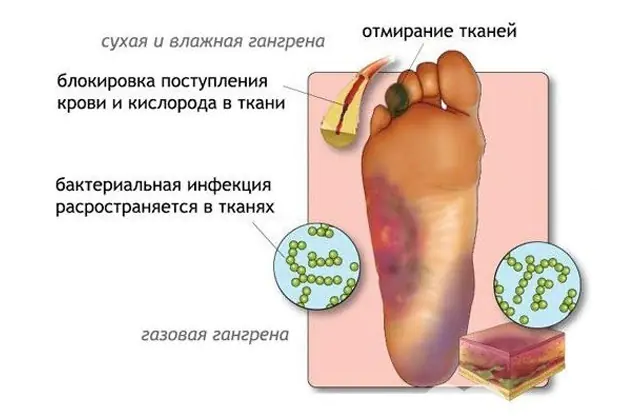
What is gangrene, the causes of the disease, classification and symptoms. Diagnostic methods, traditional and surgical treatment. Traditional recipes and preventive measures.
The content of the article:- Causes
- Types and symptoms of gangrene
- Dry
- Wet
- Gas
- Diagnostic features
- Treatment options
- Medicines
- Surgical intervention
- ethnoscience
- Prevention of gangrene
Gangrene is the death of areas of the body or organs, accompanied by pain and subsequent loss of sensation. Fabrics change shade to bluish or brown. The patient suffers from severe intoxication. Treatment most often involves amputation or removal of dead tissue.
Causes of gangrene
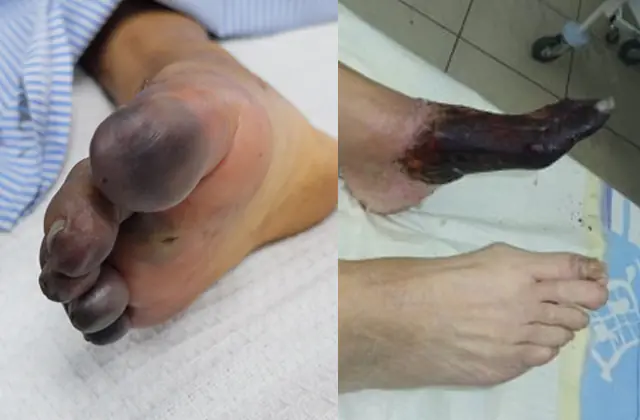
The photo shows gangrene of the legs
Gangrene is necrosis (death) of living body tissue. The disease develops against the background of deterioration or cessation of blood circulation, which leads to cell death. Iron sulfide released during the breakdown of hemoglobin gives such areas dark shades (black, bluish, brown).
Gangrene is characterized by severe intoxication of the body. The pathology is accompanied by severe pain, which the patient can hardly bear. Traditional treatment rarely produces positive results. Often a limb has to be amputated.
The development of gangrene is promoted by the influence of external factors. Under their influence, vasospasm occurs and infection with pathogenic bacteria occurs.
The causes of gangrene are divided into 4 groups:
- Physical. Tissue necrosis begins as a result of extensive trauma, leading to damage to a large number of cells. Mechanical influence is represented by wounds, fractures, punctures, etc. Thermal effects are used for burns or frostbite. Overheating in the presence of gangrene accelerates blood circulation and contributes to the transition of the pathology to a severe stage. When exposed to electric current, tissues are burned, like a burn.
- Chemical. Dry gangrene develops under the influence of chemicals. Harmful substances cause cell proteins to clot, causing them to die. The cause of the disease is not only acids, but also alkalis. They melt proteins and saponify fats. The symptoms of gangrene provoked by alkalis resemble the wet variety of the disease.
- Infectious. Tissue necrosis is caused by streptococci, E. coli, anaerobic and enterobacteria. Typically, pathology develops after deep wounds, as a result of tissue crushing. However, in diseases that cause circulatory disorders and immunodeficiency, gangrene is possible after small wounds and abrasions.
- Poor circulation. A symptom of some diseases is insufficient tissue nutrition. Such pathologies include diabetes, atherosclerosis, embolism, and serious cardiac disorders.
One of the causes of gangrene may be a violation of the integrity or compression of a large vessel, even if the tissue around it is not damaged. The situation is typical for patients who are forced to wear plaster casts or tourniquets for a long time, who have received stabbing or cutting wounds in the area of an artery or vein.
Conditions that weaken the body as a whole accelerate the development of gangrene:
- avitaminosis;
- freezing;
- slowing down metabolism;
- changes in blood composition;
- exhaustion;
- intoxication;
- anemia;
- pathologies of acute and chronic nature.
Local factors contributing to gangrene include structural features of blood vessels and tissues. Thus, the brain and lungs are more susceptible to damage than fat cells.
Types and symptoms of gangrene
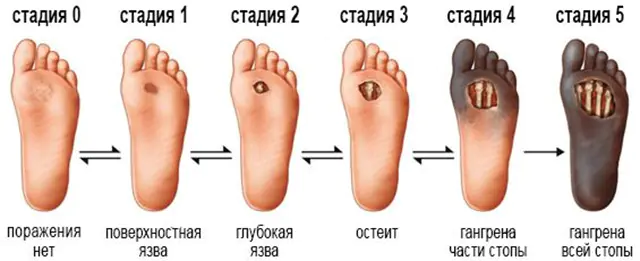
Taking into account the characteristics of the development of the disease, several types of gangrene are distinguished. Each of them has its own characteristics, stages and signs.
Dry gangrene

This form of gangrene can be called gentle: the threat to the patient’s life is minimal. Dry type pathology develops if circulatory impairment occurs gradually. The disease is typical for exhausted or dehydrated people with a wiry build.
Dry gangrene develops over several months and even years. The general well-being of a person remains almost unchanged due to mild intoxication. What dry gangrene looks like is easy to understand if you know about the processes of mummification. The tissues wrinkle, become dry and dense, and acquire a black or bluish tint.
Understanding how dry gangrene begins, you can easily recognize it by its symptoms:
- soreness of the limbs;
- the skin takes on a marbled hue;
- lack of pulse;
- feeling of coldness, numbness;
- there is no smell of a rotting body.
The boundary between healthy and diseased tissues is clearly visible (it is designated by the term “demarcation shaft”). Beginning in remote parts of the arms and legs, gangrene of the extremities gradually moves to areas with normal blood supply. Dead tissue is rejected after some time. Since the breakdown of cells is not clearly visible, amputation of the limb is possible when the border between the healthy and necrotic area is clearly formed.
Important! For the dry type of pathology, strictly follow the rules of asepsis to prevent gangrene from turning into a wet form.Wet gangrene
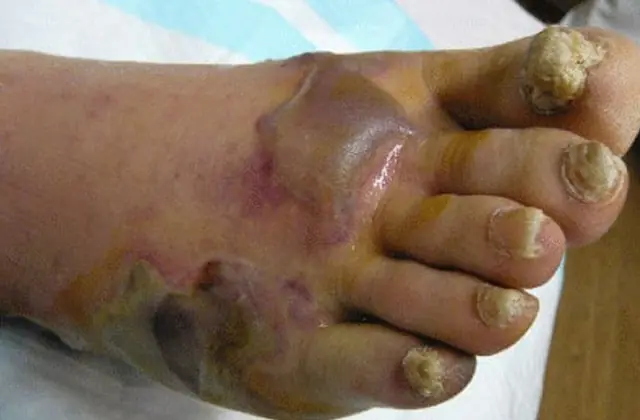
The photo shows wet diabetic gangrene of the lower extremities
Gangrene, in which the tissues rot but do not dry out, is called wet gangrene. The process begins acutely, proceeds quickly and is accompanied by severe intoxication. Pathogenic microorganisms multiply in dying tissues and further worsen the patient's condition.
Signs of gangrene of the wet type:
- fabrics remain damp;
- rotting quickly spreads to the healthy zone;
- there is no clear boundary of dead tissue;
- the skin in the early stages is pale, cool, with a marbled tint;
- swelling;
- stench;
- severe dehydration;
- reddish blisters with ichor;
- the network of venous vessels is clearly visible;
- no pulse.
In the late stage of gangrene, the dead tissue becomes black and decomposes. The patient's condition worsens: the body temperature rises, the pulse quickens with low blood pressure, lethargy and dry mouth occur. If the limb is not amputated, sepsis begins, which ends in death.
Gangrene in diabetes is especially difficult. With this disease, blood circulation in the body is disrupted, immunity decreases, and metabolism slows down. These features accelerate tissue necrosis. Gangrene can affect not only the limbs, but also internal organs.
Important! To prevent the infection from spreading to areas with normal blood circulation, in case of wet gangrene, the necrotic area is amputated at an early stage of the pathology.Gas gangrene
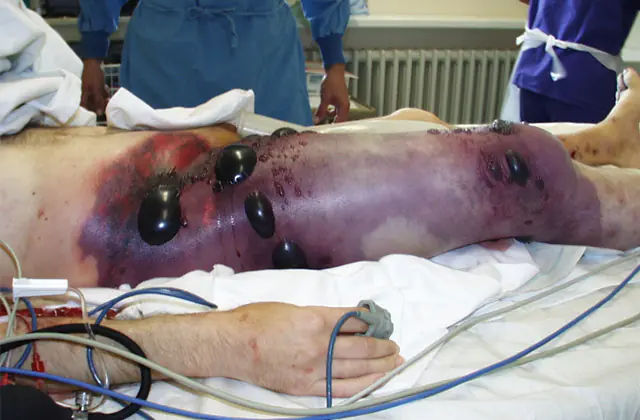
This type of gangrene develops as a result of complications of lacerations and extensive injuries. If dirt or soil gets onto the affected area, a positive environment is created for the proliferation of pathogenic microorganisms. The waste product of bacteria becomes a gas with a special odor.
The incubation period of anaerobic microorganisms is 2 days. Then they begin to multiply rapidly. The process is accompanied by intoxication and swelling. The gas accumulates in the tissues and causes them to rot.
Gas gangrene is distinguished by the following symptoms:
- nausea;
- cardiopalmus;
- dark skin around the wound;
- severe pain;
- temperature increase;
- rapid breathing;
- low blood pressure;
- unpleasant odor;
- release of gas and dark liquid when pressing on the edges of the affected area.
The patient feels unwell and there is a risk of shock.
Features of gangrene diagnosis
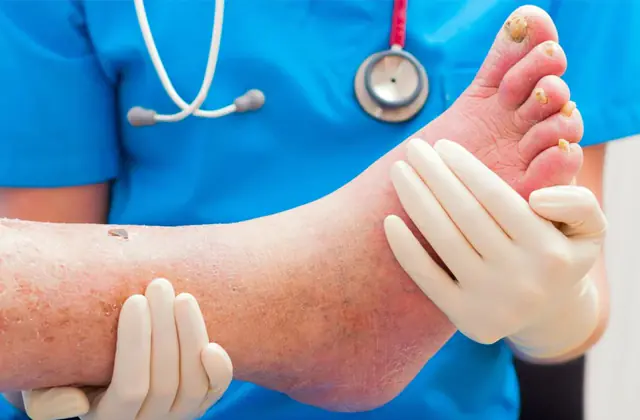
When gangrene begins, you should contact orthopedists, traumatologists or surgeons. Depending on the factors that caused the disease, the patient is referred to the appropriate department of the hospital or to a specialist.
Diagnosis of gangrene includes tests:
- blood;
- fluid oozing from the wound;
- glucose and cholesterol levels (for diabetes or atherosclerosis);
- blood for sterility (to check for sepsis);
- Ultrasound (if internal organs are damaged);
- skin biopsy;
- angiography (contrast study of blood vessels).
Methods for treating gangrene
The obtained diagnostic results enable the doctor to make an accurate diagnosis and begin treatment for gangrene. Its main goal is to stop the process of tissue necrosis.
Medicines to treat gangrene
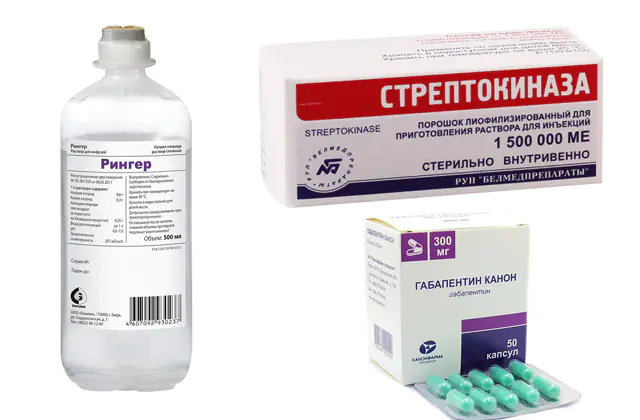
How to treat gangrene depends on the stage of the disease. Drug therapy is used in the early stages or as part of surgical treatment.
To alleviate the patient's condition, use:
- Injections of saline solution, glucose, Ringer's solution (multicomponent saline solution). These measures are necessary to restore the water-salt balance. Since the patient loses a lot of fluid during gangrene, intravenous injections help improve blood circulation.
- Administration of blood substitutes (sterile fluids that replace blood) or blood plasma. They are necessary to restore the volume of intercellular fluid and the acid-base balance of the blood. There is a huge variety of blood products. The doctor chooses the medication based on the diagnosis.
- Novocaine blockades. A therapeutic method in which novocaine is injected into the tissue. The drug “works” as an irritant that improves the supply of tissues with nutrients. The medicine combines well with antibiotics.
- Drugs that stop blood clots. Since gangrene causes increased blood clotting, anticoagulants are used. These are medications that prevent thrombosis (Streptokinase, Urokinase and others). They improve blood circulation and metabolism.
- Vitamin therapy. To strengthen the patient's immunity, injections of vitamins A, C, and group B are used. They are necessary for normal hematopoiesis and accelerating the regeneration of skin cells.
- Antibiotic therapy. Antibacterial drugs for gangrene are administered intravenously or intramuscularly for accelerated action. If the cause of tissue death is an infection, the medication is selected depending on the pathogen. In preparation for and after surgery, a course of antibiotics is also required.
- Painkillers. Since the disease is accompanied by increased pain, anesthetics are prescribed in the form of injections (Gabapentin, Gabagamma, etc.).
- Wound dressings with antiseptic ointments (Levosin, Levomekol). The purpose of compresses is to stop the spread of infection.
Depending on the concomitant disease, additional measures for gangrene are prescribed:
- For diabetes, drug therapy includes treatment with insulin.
- If the causative agent of the disease is anaerobic bacteria, hyperbaric oxygen therapy is used. The patient is placed in a special chamber with a high oxygen content. Thanks to the oxygen enrichment of the blood, the growth of pathogenic microorganisms slows down and wounds heal.
- In case of dry gangrene, the ulcers are treated with ultraviolet light and an alcohol solution of tannin to prevent the disease from passing into a wet form.
Additional treatment methods also do not exclude surgery.
Surgery for gangrene
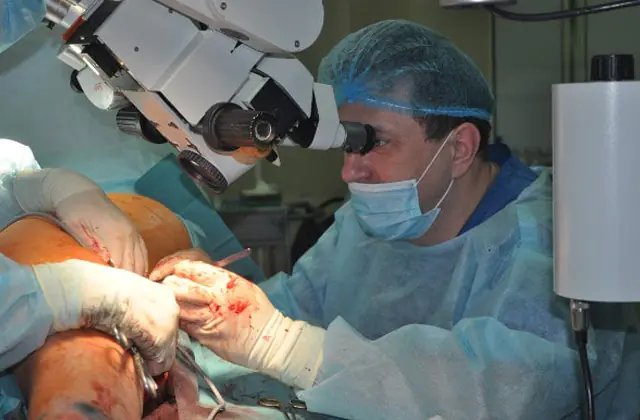
Since dead tissue is not restored and must be removed, surgical intervention is present at all stages of gangrene. Surgical treatment is used not only to amputate a limb, but also to prevent the spread of necrosis to healthy tissue:
- Removing dead skin areas. This type of operation is used when the pathology affects only the skin and does not affect the deep tissues. The doctor removes flaps of skin so that gangrene does not spread to neighboring organs and tissues. To restore the integrity of the skin, transplantation (skin grafting) is used.
- Vascular microsurgery. If the cause of the disease is a circulatory disorder due to changes in the functioning of the heart and blood vessels, the surgeon performs shunting (creating an additional path for blood flow if the vessel is damaged) or other operations to normalize blood flow. Along with this, heart medications are prescribed.
- X-ray endovascular surgery. Operations to restore blood vessels without making incisions on them. Manipulations are carried out through small skin incisions using micro-instruments. The progress of the operation is monitored using radiation visualization methods.
- Amputation. In severe cases, when other treatment methods fail, the limb is amputated. This requires serious testimony. In case of wet gangrene, it is removed in extreme cases to save the patient’s life.
The operation does not guarantee that the disease will not recur in the future. To avoid relapse, follow preventive measures.
Traditional medicine against gangrene
Recommendations from traditional healers help alleviate the suffering of the patient, and sometimes get rid of the disease in the early stages. The essence of non-traditional methods of treating gangrene is to normalize blood circulation in small vessels and capillaries. For this purpose the following is carried out:
- Massage. Kneading, stroking, pinching the sore limb provides a rush of blood and inhibits tissue death. The procedure should take at least 10 minutes every day.
- Warm baths. Heat the water to 37 degrees. For the first week, warm your feet with mustard, taking 1 tbsp per 2 liters of water. l. The second week, add 1 tbsp to 1 liter of water. l. sea salt. During the procedure, actively massage your fingers for 20 minutes. Do not take hot baths: with gangrene, they worsen the patient's condition.
- Means for blood vessels. To strengthen blood vessels and make the blood more fluid, drink 1 tbsp every day. l. garlic tinctures. To prepare it, take 3 cloves of garlic, fill them with a small amount of water (1 part garlic to 1 part water) and add 1 tbsp. l. olive oil.
- Compresses with rye bread. Salt the rye bread and chew it well. Apply the crumb to the affected areas. Grind the bread by chewing: other methods will not give results.
- Compresses with onions and clay. Take red clay and chopped onion in equal parts. Add a little vinegar to make a thick dough. Apply to the sore spot and wrap with polyethylene. When the mixture dries, replace it with fresh one.
Before starting treatment for gangrene with traditional recipes, agree on the specifics of therapy with your doctor.
Prevention of gangrene
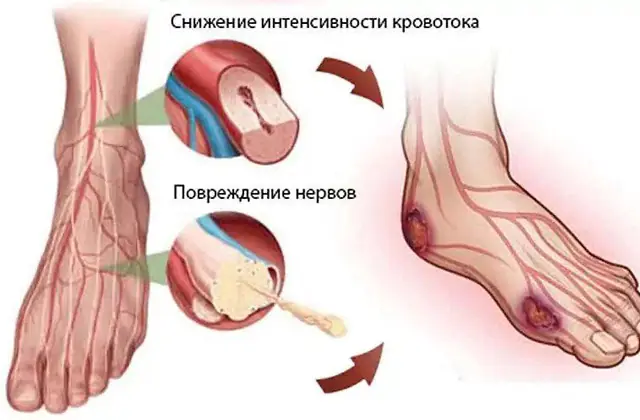
If left untreated, the consequences of gangrene include blood poisoning and death. A more favorable prognosis awaits patients with the dry type of pathology. In this case, the infection spreads slowly and can be stopped.
In older people and patients with weakened bodies, complications of gangrene appear faster and are more severe. With heart disease, the patient may not be able to withstand amputation. In this case, there is a high risk of death.
Measures to prevent gangrene are important not only in the absence of the disease, but also during its course. They are as follows:
- Regular examination and treatment for problems with the heart and blood vessels. If a patient has vascular spasms or has had damage to the cardiovascular system in the past, he should be under regular medical supervision. Poor circulation becomes a prerequisite for the development of gangrene.
- Excess weight control. Obesity and diabetes lead to changes in metabolism. Blood does not reach distant organs and tissues, which is dangerous due to their gradual death.
- Getting rid of bad habits. Alcohol and smoking lead to sharp spasms of blood vessels.
- Careful wound care. If you are injured, the wound must be washed well and treated with antiseptics. When it is not possible to do this at home, consult a doctor.
- Avoid overheating, burns and frostbite. When exposed to extremely high or low temperatures, tissue death occurs.
Gangrene is easier to prevent. Remember: the disease is difficult to treat, and necrotic tissue does not recover. Follow the rules of prevention and get tested regularly.
Video about gangrene in diabetes mellitus - prevention and treatment:



